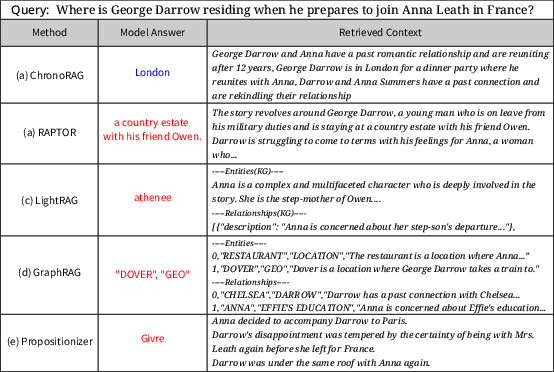- The paper introduces ChronoRAG, a novel RAG extension that employs a two-stage graph construction and hierarchical retrieval process to enhance narrative coherence.
- It demonstrates superior performance on the NarrativeQA dataset, achieving 0.308 on the full set and 0.268 on time-specific queries.
- ChronoRAG maintains narrative flow by integrating entity-relation extraction and precise passage indexing to preserve temporal order.
Chronological Passage Assembling in RAG Framework for Temporal Question Answering
Introduction
Temporal question answering over narrative texts is a complex task due to the necessity of reconstructing a coherent timeline of events while maintaining contextual flow. The paper introduces "ChronoRAG," a specialized Retrieval-Augmented Generation (RAG) framework, aimed at addressing these challenges by enhancing the handling of narrative tasks. This approach posits that understanding narratives requires acknowledgment of sequential relationships, rather than merely isolated segments. ChronoRAG refines document information into coherent passages while preserving narrative flow through capturing and maintaining temporal order.
Methodology
The core innovation of ChronoRAG lies in its approach to retaining narrative structure and temporal coherence. This methodology is implemented through a two-stage process involving initial graph construction followed by passage retrieval and answer generation.
- Graph Construction:
- Document Chunking: The document is divided into fixed-length chunks, forming the basis of the hierarchical graph.
- Chunk Summarization: Chunks are summarized to distill complex passages into concise representations.
- Entity-Relation Extraction: Entity extraction is performed alongside relation generation to form Layer 1 of the hierarchical graph, focusing on precision and coherence.
- Indexing: Intra-narrative indices are assigned to the relations and original chunks ensuring sequential and contextual coherence.
- Neighborhood Assembling: Retrieved relational descriptions are augmented with their context to maintain the narrative flow.
- Passage Retrieval and Answer Generation:
Experimental Results
The empirical evaluation is conducted on the NarrativeQA dataset, including a specially isolated subset of "Time Questions." ChronoRAG demonstrates superior performance, particularly in tasks requiring comprehension of temporal relationships. It outperforms baselines such as RAPTOR, LightRAG, and GraphRAG, affirming the advantages of maintaining chronological context.
Results indicated that increased passage retrieval accuracy results from better temporal ordering, yielding 0.308 on the full dataset and 0.268 on the Time Questions subset. It is noted that, though RAPTOR performs well, it suffers from omitting critical details due to summarization layers, while LightRAG and GraphRAG encounter deficiencies due to excessive nodes or omitted filtering stages.

Figure 2: Retrieval comparison for a narrative query. (a) Fine-grained indexing returns standalone sentences. (b) Chronological assembly preserves narrative flow.
Discussion
ChronoRAG introduces a robust mechanism for addressing temporal questions by reformulating the classical RAG approach with additional structure to respect narrative contexts. The paper postulates that narrative comprehension is significantly improved by addressing sequential coherence rather than isolated fact retrieval. Moreover, ChronoRAG demonstrates computational efficiency with minimal LLM calls, underscoring its practicality in real-world applications.

Figure 3: Retrieved context per method.
Conclusion
ChronoRAG presents a significant advancement in temporal question answering by integrating chronological context within the RAG framework. By enhancing narrative structuring through its unique methodology, ChronoRAG not only performs well empirically but also highlights a pathway for future research in temporal reasoning and narrative comprehension, suggesting continued exploration of temporal coherence and contextualization in NLP applications.




